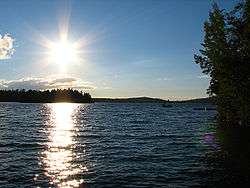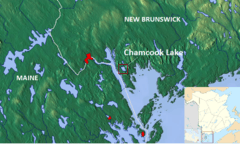Chamcook Lake
| Chamcook Lake | |
|---|---|
 | |
 | |
| Location | Saint Andrews Parish, New Brunswick, Canada |
| Coordinates | 45°08′41″N 67°05′27″W / 45.14472°N 67.09083°W |
| Surface area | 337 hectares (830 acres) |
| Average depth | 60 feet (18 m) |
| Max. depth | 137 ft (42 m) |
| Surface elevation | 29 metres (95 ft) |
| Islands | Odell Island; Big Rock |
Chamcook Lake is a lake of Saint Andrews Parish, New Brunswick, Canada. It is located just north of the Passamaquoddy Bay[1] which is part of the Bay of Fundy, near the border with Maine, United States.[2] The town of Chamcook, New Brunswick lies on the eastern bank of the lake and Chamcook Mountain is nearby. The lake has been notable within New England and Canada for its fishing.[2]
Etymology
Chamcook comes from the Passamaquoddy word K'tchumcook which, according to William Francis Ganong, has many meanings but none are certain.[3]
Geography
Chamcook Lake is approximately 1.5 miles (2.4 km) from Passamaquoddy Bay.[4] The lake is connected by road to St. Stephen, New Brunswick.[5] A Canadian Pacific Railway freight service station has been located at Chamcook Lake.[6]

The lake is situated at 95 feet (29 m) above sea level, and has a maximum depth of 200 feet (61 m).[4] The Chamcook River which feeds the Chamcook Lake rises from the cone shaped hill range of Mt. Chamcook. The Chamkcook harbour, a wet dock, lies is to the eastern side of the peninsular where development took place.[7] It contains Odell Island in the southeast and Big Rock in the north. Despite its name, the Odell Island is larger than Big Rock. Approximately 2.2 miles (3.5 km)[8] to the north beyond Big Rock is a sister lake named Little Chamcook Lake. The Chamcook Lake watershed serves as a potable water supply for the Atlantic Salmon Federation, the St. Andrews Biological Station, the Champlain Industrial Park, and the town of St. Andrews.[9]
The lake's red rock is feldspathic, of a brownish-red colour that weathers to brick-red, imperfectly syenitic, and showing some indications of an eruptive origin.[10] A set of very fine petro-siliceous rocks, which are almost black, but have a perceptible purplish tinge are situated on the western shore.[11]
The steep and solitary Chamcook Mountain overlooks the lake.[12] The mountain has a glacial rounded top scored with long scratches which indicate that a glacier from the northern highlands had grated its way across the mountain.[13] The Chamcook Lake and the Chamcook mountain are both located in the Silurian belt of huge sandstones which has fossiliferous and volcanic formations in different sections.[14]
- Ecology
After an advisory warning was issued in September 2010 for bloom of blue green algae,[15] no detectable toxins were found in the town’s drinking water supply, which comes from the lake, though officials continued to monitor the water supply.[16]
Flora

Chamcook Lake contains populations of Vitrea and in the 1930s a new species of Holopedium was discovered in the area.[17][18] Lymnaea is found mainly along the lake's margin, composed chiefly of Isoetes echinospora; Sagittaria montevidensis; Potamogeton gramineus; Potamogeton spirillus; and the aquatic form of Hypericum boreale.[19] Ground Cedar is found on the lake's dry bank and Isoetes echinospora is frequent along the lake's south margin.[20]
The mushroom Boletus luridus Schaef. vermiculosus Pk has been found nearby.[21] Of the Halophytes, Sagittaria latifolia, Sagittaria cuneata, Alopecurus aequalis, Glyceria borealis, Eleocharis acicularis, Acorus calamus, and Juncus pelocarpus are noted along the lake margins.[19] The fern vegetation found on the lake's shores and along the stream which flows out from the Chamcook Lake to the sea are Diphasiastrum complanatum, Diphasiastrum digitatum, and Isoetes echinospora.[22]
Fauna
In 1886, 200,000 salmon and salmon trout fry (young trout) were deposited in the lake.[23] Fish species reported from the lake included sockeye salmon, steelhead trout and brown trout.[24] During certain times of the year, it is said to contain heavy populations of sebago salmon.[25] Studies conducted into the methylmercury concentration of eels from Chamcook Lake in the early 1970s indicated elevated levels of mercury in the lake's ecosystem, although brook trout from the lake revealed only 0.03 ppm.[26]
See also
References
- ↑ Douglas-Lithgow, R. A. (1 March 2001). Native American Place Names of Maine, New Hampshire, & Vermont. Applewood Books. p. 11. ISBN 978-1-55709-541-1. Retrieved 3 April 2011.
- 1 2 Sweetser, Moses Foster; Boston and Maine Railroad (1889). Here and there in New England and Canada ... Passenger Dept. Boston & Maine Railroad. pp. 144–. Retrieved 3 April 2011.
- ↑ Hamilton, William Baillie (1996). Place names of Atlantic Canada. University of Toronto Press. pp. 61–. ISBN 978-0-8020-7570-3. Retrieved 3 April 2011.
- 1 2 Natural History Society of New Brunswick (1908). Bulletins. pp. 294–. Retrieved 3 April 2011.
- ↑ New Brunswick. House of Assembly (1835). Journals of the House of Assembly of the Province of New Brunswick. Printer to the Queen's Most Excellent Majesty. p. 431. Retrieved 3 April 2011.
- ↑ American Association of Passenger Traffic Officers; National Railway Publication Co. (1904). The Official railway guide: North American freight service edition. National Railway Publication Co. pp. 1041–. Retrieved 3 April 2011.
- ↑ Abraham Gesner (1847). New Brunswick: with notes for emigrants. Comprehending the early history, an account of the Indians, settlement ... Simmonds & Ward. pp. 130–. Retrieved 4 April 2011.
- ↑ "Chamcook Lake, New Brunswick, Canada". travelingluck.com. Retrieved 3 April 2011.
- ↑ "NEW BRUNSWICK REGULATION 90–122". gnb.ca. October 12, 1990. Archived from the original on 28 March 2010. Retrieved 3 April 2011.
- ↑ Geological Survey of Canada (1872). Report of Progress. pp. 187–. Retrieved 3 April 2011.
- ↑ Geological Survey of Canada (1876). Report of Progress. p. 88. Retrieved 3 April 2011.
- ↑ Roberts, Sir Charles George Douglas (1891). The Canadian guide-book: the tourist's and sportsman's guide to eastern Canada and Newfoundland ; including full descriptions of routes, cities, points of interest, summer resorts, fishing places, etc. ... D. Appleton. pp. 181–. Retrieved 3 April 2011.
- ↑ Maritime provinces (1875). M.F. Sweetser, ed. The Maritime provinces: a handbook for travellers. pp. 33–. Retrieved 3 April 2011.
- ↑ Contributions to Canadian biology. Biological Board of Canada, Canada. Marine Biological Station. 1914. Retrieved 4 April 2011.
- ↑ "Advisory for Chamcook Lake, New Brunswick". water.ca. The Water Chronicles. Archived from the original on 15 January 2013. Retrieved 3 April 2011.
- ↑ Rayner, Barb (September 9, 2010). "No toxins found in St. Andrews water supply". St. Croix Courier. Retrieved 3 April 2011.
- ↑ Biological Board of Canada; Canada. Marine Biological Station (1925). Contributions to Canadian biology. Biological Board of Canada. p. 35. Retrieved 3 April 2011.
- ↑ Proceedings of the Nova Scotian Institute of Science. Nova Scotian Institute of Science. 1935. Retrieved 3 April 2011.
- 1 2 Biological Board of Canada; Canada Marine Biological Station (1901). Contributions to Canadian biology. Biological Board of Canada. pp. 266–. Retrieved 3 April 2011.
- ↑ Willard Nelson Clute; American Fern Society (1909). The fern bulletin. Fern Bulletin Co. pp. 7–. Retrieved 3 April 2011.
- ↑ "Boletus luridus Schaef. vermiculosus Pk. near Chamcook Lake, St. Andrews N. B. July 18th, 1900". McCord Museum of Canadian History. July 18, 1900. Retrieved 3 April 2011.
- ↑ American Fern Society; Linnaean Fern Chapter (1911). The Fern bulletin: a quarterly devoted to ferns. The Fern Bulletin Co. p. 7. Retrieved 4 April 2011.
- ↑ Canada. Parliament (1887). Sessional papers. C. H. Parmelee. pp. 34–. Retrieved 3 April 2011.
- ↑ "Little Chamcook Lake Fishing near Saint Andrews, New Brunswick". Hook and bullet.com. Retrieved 4 April 2011.
- ↑ Annual Report on Fish Culture. Canada. Dept. of Fisheries, Printer to the King. 1 January 1941. p. 31. Retrieved 3 April 2011.
- ↑ Fisheries Research Board of Canada; Biological Board of Canada (1 January 1971). Journal of the Fisheries Research Board of Canada. University of Toronto Press. p. 1286. Retrieved 3 April 2011.
| Wikimedia Commons has media related to Chamcook Lake. |
http://www.muskiesnb.ca/hydrographic%20mapping/NB%20Lakes.pdf